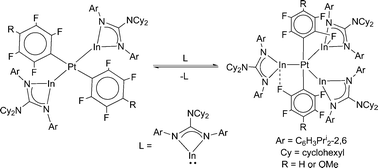Complexes of four-membered group 13 metal(I) N-heterocyclic carbene analogues with platinum(II) fragments†
Abstract
A series of fluorinated bis(aryl)platinum(II) complexes, cis-[Pt(Arf)2(1,5-C6H10)] (Arf = p-C6HF4, p-C6(OMe)F4 or C6H2F3−2,4,6) were reacted with the four-membered gallium(I) or indium(I) heterocycles, [:E{[N(Ar)]2CN(C6H11)2}] (E = Ga or In, Ar = C6H3Pri2−2,6) under various stoichiometries. These yielded either the 2:1 complexes, cis-[Pt(Arf)2{Ga{[N(Ar)]2CN(C6H11)2}}2], trans-[Pt(C6H2F3-2,4,6)2{Ga{[N(Ar)]2CN(C6H11)2}}2] and trans-[Pt(Arf)2{In{[N(Ar)]2CN(C6H11)2}}2], or the 3:1 complexes, trans-[Pt(Arf)2{In{[N(Ar)]2CN(C6H11)2}}3] (Arf = p-C6HF4 or p-C6(OMe)F4), all of which were crystallographically characterised. The differing outcomes of these reactions are explained in terms of the lesser nucleophilicity and greater electrophilicity of the indium heterocycle relative to its gallium counterpart. In the solid state, and in solution, the 3:1 indium complexes exhibit strong intramolecular In⋯F interactions which are indicative of their heterocyclic


 Please wait while we load your content...
Please wait while we load your content...